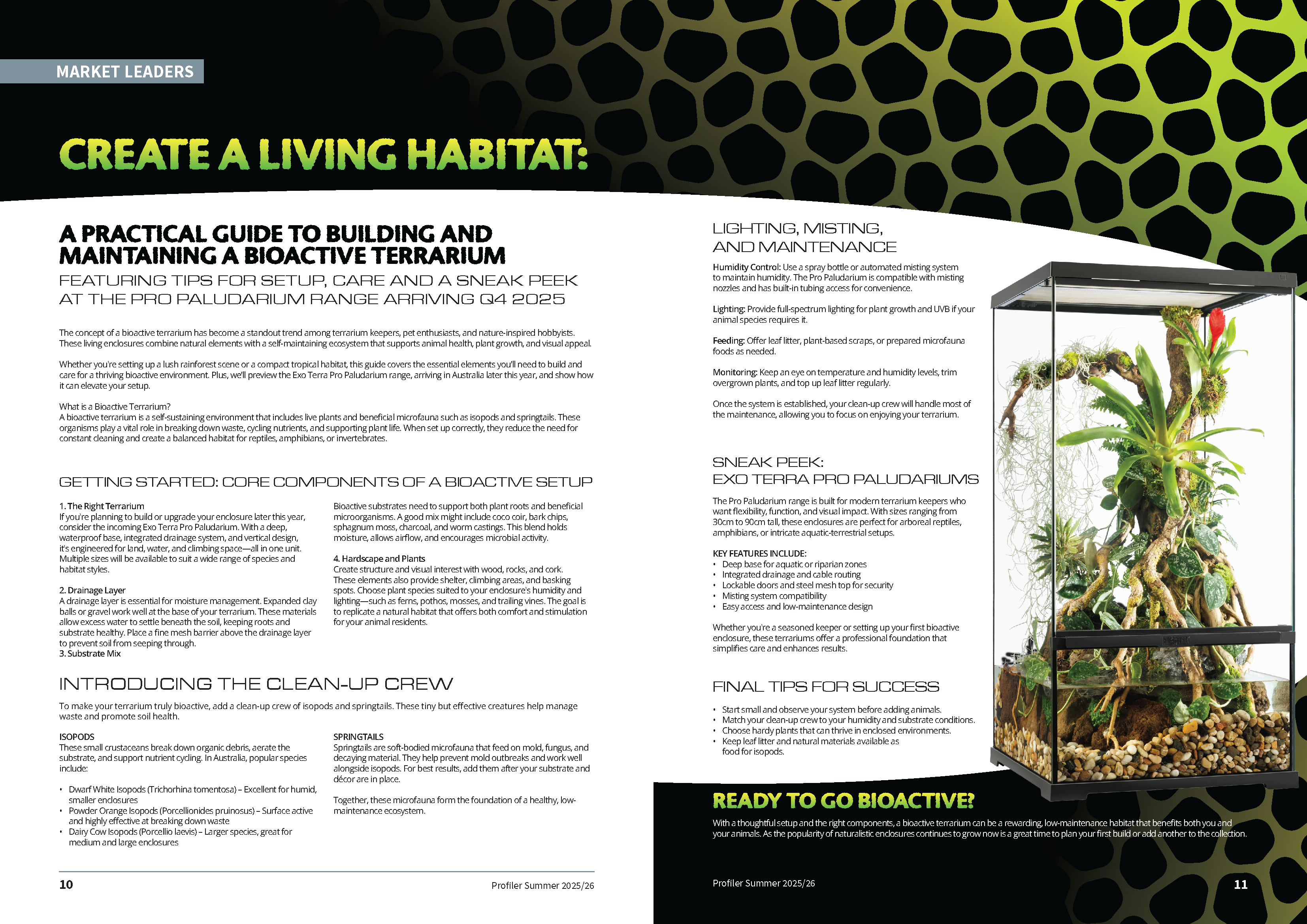Exo Terra: Creating A Living Habitat
Posted by Aquarium Spare Parts on 3rd Nov 2025
A PRACTICAL GUIDE TO BUILDING AND MAINTAINING A BIOACTIVE TERRARIUM
FEATURING TIPS FOR SETUP, CARE AND A SNEAK PEEK AT THE PRO PALUDARIUM RANGE ARRIVING Q4 2025
The concept of a bioactive terrarium has become a standout trend among terrarium keepers, pet enthusiasts, and nature-inspired hobbyists. These living enclosures combine natural elements with a self-maintaining ecosystem that supports animal health, plant growth, and visual appeal.
Whether you're setting up a lush rainforest scene or a compact tropical habitat, this guide covers the essential elements you’ll need to build and care for a thriving bioactive environment. Plus, we’ll preview the Exo Terra Pro Paludarium range, arriving in Australia later this year, and show how it can elevate your setup.
What is a Bioactive Terrarium?
A bioactive terrarium is a self-sustaining environment that includes live plants and beneficial microfauna such as isopods and springtails. These organisms play a vital role in breaking down waste, cycling nutrients, and supporting plant life. When set up correctly, they reduce the need for constant cleaning and create a balanced habitat for reptiles, amphibians, or invertebrates.
GETTING STARTED: CORE COMPONENTS OF A BIOACTIVE SETUP
1. The Right Terrarium
If you're planning to build or upgrade your enclosure later this year, consider the incoming Exo Terra Pro Paludarium. With a deep, waterproof base, integrated drainage system, and vertical design, it's engineered for land, water, and climbing space—all in one unit. Multiple sizes will be available to suit a wide range of species and habitat styles.
2. Drainage Layer
A drainage layer is essential for moisture management. Expanded clay balls or gravel work well at the base of your terrarium. These materials allow excess water to settle beneath the soil, keeping roots and substrate healthy. Place a fine mesh barrier above the drainage layer to prevent soil from seeping through.
3. Substrate Mix
Bioactive substrates need to support both plant roots and beneficial microorganisms. A good mix might include coco coir, bark chips, sphagnum moss, charcoal, and worm castings. This blend holds moisture, allows airflow, and encourages microbial activity.
4. Hardscape and Plants
Create structure and visual interest with wood, rocks, and cork. These elements also provide shelter, climbing areas, and basking spots. Choose plant species suited to your enclosure's humidity and lighting—such as ferns, pothos, mosses, and trailing vines. The goal is to replicate a natural habitat that offers both comfort and stimulation for your animal residents.
INTRODUCING THE CLEAN-UP CREW
To make your terrarium truly bioactive, add a clean-up crew of isopods and springtails. These tiny but effective creatures help manage waste and promote soil health.
ISOPODS
These small crustaceans break down organic debris, aerate the substrate, and support nutrient cycling. In Australia, popular species include:
• Dwarf White Isopods (Trichorhina tomentosa) – Excellent for humid, smaller enclosures
• Powder Orange Isopods (Porcellionides pruinosus) – Surface active and highly effective at breaking down waste
• Dairy Cow Isopods (Porcellio laevis) – Larger species, great for medium and large enclosures
SPRINGTAILS
Springtails are soft-bodied microfauna that feed on mold, fungus, and decaying material. They help prevent mold outbreaks and work well alongside isopods. For best results, add them after your substrate and décor are in place.
Together, these microfauna form the foundation of a healthy, low-maintenance ecosystem.
LIGHTING, MISTING, AND MAINTENANCE
Humidity Control: Use a spray bottle or automated misting system
to maintain humidity. The Pro Paludarium is compatible with misting nozzles and has built-in tubing access for convenience.
Lighting: Provide full-spectrum lighting for plant growth and UVB if your animal species requires it.
Feeding: Offer leaf litter, plant-based scraps, or prepared microfauna foods as needed.
Monitoring: Keep an eye on temperature and humidity levels, trim overgrown plants, and top up leaf litter regularly.
Once the system is established, your clean-up crew will handle most of the maintenance, allowing you to focus on enjoying your terrarium.
SNEAK PEEK: EXO TERRA PRO PALUDARIUMS
The Pro Paludarium range is built for modern terrarium keepers who want flexibility, function, and visual impact. With sizes ranging from 30cm to 90cm tall, these enclosures are perfect for arboreal reptiles, amphibians, or intricate aquatic-terrestrial setups.
KEY FEATURES INCLUDE:
• Deep base for aquatic or riparian zones
• Integrated drainage and cable routing
• Lockable doors and steel mesh top for security
• Misting system compatibility
• Easy access and low-maintenance design
Whether you're a seasoned keeper or setting up your first bioactive enclosure, these terrariums offer a professional foundation that simplifies care and enhances results.
FINAL TIPS FOR SUCCESS
• Start small and observe your system before adding animals.
• Match your clean-up crew to your humidity and substrate conditions.
• Choose hardy plants that can thrive in enclosed environments.
• Keep leaf litter and natural materials available as food for isopods.
READY TO GO BIOACTIVE?
With a thoughtful setup and the right components, a bioactive terrarium can be a rewarding, low-maintenance habitat that benefits both you and your animals. As the popularity of naturalistic enclosures continues to grow now is a great time to plan your first build or add another to the collection.



